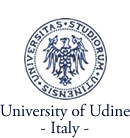
|
IT for Preservation and Dissemination of Cultural Heritage
HYDERABAD – Monday, 29th August 2005
Inauguration of the Workshop: Dr. L. GASTALDI, Dr. B.G. SIDHARTH, Prof. F. HONSELL
Keynote Address: Dr. C.S. RAO
Workshop on "IT for Preservation and Dissemination of Cultural Heritage"
HYDERABAD – Tuesday, 30th August 2005
Keynote Address: Dr. T. TSITIDOU
Workshop on "IT for Preservation and Dissemination of Cultural Heritage"
Summer School on IT
- Dr. Paolo COPPOLA, “XML and digitization” (2 h.)
- Dr. Roberto RANON, "Web3D Technologies and their use in education, learning and training" (2 h.)
HYDERABAD – Wednesday, 31 August 2005
Workshop on "IT for Industry, Education and Research"
Summer School on IT
- Dr. Paolo COPPOLA, “XML and digitization” (2 h.)
- Dr. Roberto RANON, "Web3D Technologies and their use in education, learning and training" (2 h.)
HYDERABAD – Thursday, 1 September 2005
Summer School on IT
- Dr. Paolo COPPOLA, “XML and digitization” (4 h.)
- Dr. Roberto RANON, "Web3D Technologies and their use in education, learning and training" (4 h.)
PUNE – Friday, 2 September 2005
Workshop on “ICT for Cross Cultural Fertilization”
Summer School’s Lessons Contents
“XML and digitization”
Dr. Paolo COPPOLA
Developing high-quality digital content is central to improving public access to cultural heritage information, as well as to promoting teaching and research. The course will introduce the basis of digitization of texts, images, audio and video. We will define the concepts of character encoding, resolution and sampling, focusing on the pros and cons of digitization. In the second part of the course we will introduce the basis of XML. We will see what metadata are and how can be added to digital content using the XML standard.
"Web3D Technologies and their use in education, learning and training"
Dr. Roberto RANON
Virtual environments offer the possibility to recreate the real world as it is or to create completely new worlds, providing experiences that can help people in understanding concepts as well as learning to perform specific tasks. However, developing and delivering educational virtual environments with traditional and/or proprietary Virtual Reality technologies can be very expensive, and the developed solutions are not accessible to many learners. An emerging solution is provided by Web3D open standards that combine 3D interactive graphics with Web technologies to allow the delivery of interactive virtual environments through the Internet, reaching potentially large numbers of learners worldwide, at any time. The course will introduce the educational use of Virtual Reality based on Web3D technologies. After briefly presenting the main Web3D technologies, we will summarize the pedagogical basis that motivate their exploitation in the context of education and highlight their interesting features. We will also outline the main positive and negative results obtained so far, and point out some of the current research directions.

|




|



